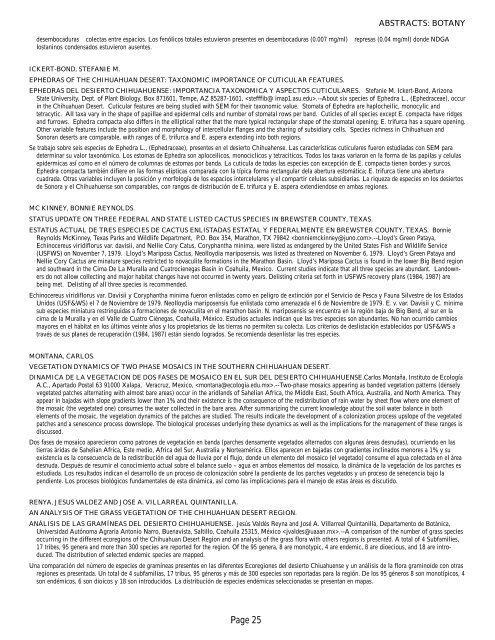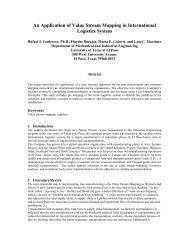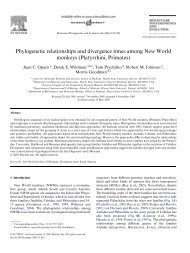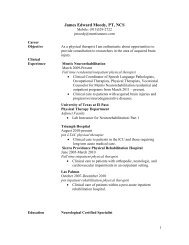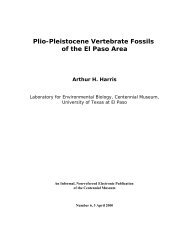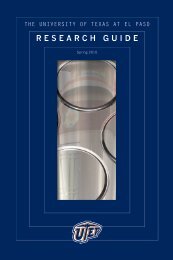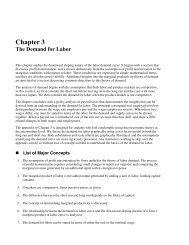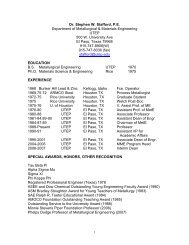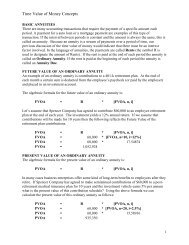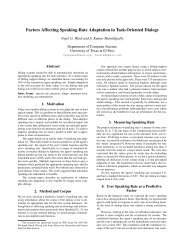Sym - Abstracts - University of Texas at El Paso
Sym - Abstracts - University of Texas at El Paso
Sym - Abstracts - University of Texas at El Paso
You also want an ePaper? Increase the reach of your titles
YUMPU automatically turns print PDFs into web optimized ePapers that Google loves.
ABSTRACTS: BOTANY<br />
desembocaduras colectas entre espacios. Los fenólicos totales estuvieron presentes en desembocaduras (0.007 mg/ml) represas (0.04 mg/ml) donde NDGA<br />
lostaninos condensados estuvieron ausentes.<br />
ICKERT-BOND, STEFANIE M.<br />
EPHEDRAS OF THE CHIHUAHUAN DESERT: TAXONOMIC IMPORTANCE OF CUTICULAR FEATURES.<br />
EPHEDRAS DEL DESIERTO CHIHUAHUENSE: IMPORTANCIA TAXONOMICA Y ASPECTOS CUTICULARES. Stefanie M. Ickert-Bond, Arizona<br />
St<strong>at</strong>e <strong>University</strong>, Dept. <strong>of</strong> Plant Biology, Box 871601, Tempe, AZ 85287-1601, .--About six species <strong>of</strong> Ephedra L., (Ephedraceae), occur<br />
in the Chihuahuan Desert. Cuticular fe<strong>at</strong>ures are being studied with SEM for their taxonomic value. Stom<strong>at</strong>a <strong>of</strong> Ephedra are haplocheilic, monocylic and<br />
tetracytic. All taxa vary in the shape <strong>of</strong> papillae and epidermal cells and number <strong>of</strong> stom<strong>at</strong>al rows per band. Cuticles <strong>of</strong> all species except E. compacta have ridges<br />
and furrows. Ephedra compacta also differs in the elliptical r<strong>at</strong>her th<strong>at</strong> the more typical rectangular shape <strong>of</strong> the stom<strong>at</strong>al opening; E. trifurca has a square opening.<br />
Other variable fe<strong>at</strong>ures include the position and morphology <strong>of</strong> intercellular flanges and the sharing <strong>of</strong> subsidiary cells. Species richness in Chihuahuan and<br />
Sonoran deserts are comparable, with ranges <strong>of</strong> E. trifurca and E. aspera extending into both regions.<br />
Se trabajo sobre seis especies de Ephedra L., (Ephedraceae), presentes en el desierto Chihuahense. Las características cuticulares fueron estudiadas con SEM para<br />
determinar su valor taxonómico. Los estomas de Ephedra son aploceilicos, monociclicos y tetraciticos. Todos los taxas variaron en la forma de las papilas y celulas<br />
epidermicas así como en el número de columnas de estomas por banda. La cuticula de todas las especies con excepción de E. compacta tienen bordes y surcos.<br />
Ephedra compacta también difiere en las formas elipticas comparada con la típica forma rectangular dela abertura estomática; E. trifurca tiene una abertura<br />
cuadrada. Otras variables incluyen la posición y morfología de los espacios intercelulares y el compartir celulas subsidiarias. La riqueza de especies en los desiertos<br />
de Sonora y el Chihuahuense son comparables, con rangos de distribución de E. trifurca y E. aspera extendiendose en ambas regiones.<br />
MC KINNEY, BONNIE REYNOLDS.<br />
STATUS UPDATE ON THREE FEDERAL AND STATE LISTED CACTUS SPECIES IN BREWSTER COUNTY, TEXAS.<br />
ESTATUS ACTUAL DE TRES ESPECIES DE CACTUS ENLISTADAS ESTATAL Y FEDERALMENTE EN BREWSTER COUNTY, TEXAS. Bonnie<br />
Reynolds McKinney, <strong>Texas</strong> Parks and Wildlife Department, P.O. Box 354, Mar<strong>at</strong>hon, TX 79842 .--Lloyd’s Green P<strong>at</strong>aya,<br />
Echinocereus viridiflorus var. davisii, and Nellie Cory C<strong>at</strong>us, Coryphantha minima, were listed as endangered by the United St<strong>at</strong>es Fish and Wildlife Service<br />
(USFWS) on November 7, 1979. Lloyd’s Mariposa Cactus, Neolloydia mariposensis, was listed as thre<strong>at</strong>ened on November 6, 1979. Lloyd’s Green P<strong>at</strong>aya and<br />
Nellie Cory Cactus are min<strong>at</strong>ure species restricted to novaculite form<strong>at</strong>ions in the Mar<strong>at</strong>hon Basin. Lloyd’s Mariposa Cactus is found in the lower Big Bend region<br />
and southward in the Cima De La Muralla and Cu<strong>at</strong>rocienegas Basin in Coahuila, Mexico. Current studies indic<strong>at</strong>e th<strong>at</strong> all three species are abundant. Landowners<br />
do not allow collecting and major habit<strong>at</strong> changes have not occurred in twenty years. Delisting criteria set forth in USFWS recovery plans (1984, 1987) are<br />
being met. Delisting <strong>of</strong> all three species is recommended.<br />
Echinocereus viridiflorus var. Davisii y Coryphantha minima fueron enlistadas como en peligro de extinción por el Servicio de Pesca y Fauna Silvestre de los Estados<br />
Unidos (USF&WS) el 7 de Noviembre de 1979. Neolloydia mariposensis fue enlistada como amenazada el 6 de Noviembre de 1979. E. v. var. Davisii y C. minima<br />
sub especies mini<strong>at</strong>ura restringuidas a formaciones de novaculita en el mar<strong>at</strong>hon basin. N. mariposensis se encuentra en la región baja de Big Bend, al sur en la<br />
cima de la Muralla y en el Valle de Cu<strong>at</strong>ro Ciénegas, Coahuila, México. Estudios actuales indican que las tres especies son abundantes. No han ocurrido cambios<br />
mayores en el hábit<strong>at</strong> en los últimos veinte años y los propietarios de las tierras no permiten su colecta. Los criterios de deslistación establecidos por USF&WS a<br />
través de sus planes de recuperación (1984, 1987) están siendo logrados. Se recomienda desenlistar las tres especies.<br />
MONTANA, CARLOS.<br />
VEGETATION DYNAMICS OF TWO PHASE MOSAICS IN THE SOUTHERN CHIHUAHUAN DESERT.<br />
DINAMICA DE LA VEGETACION DE DOS FASES DE MOSAICO EN EL SUR DEL DESIERTO CHIHUAHUENSE.Carlos Montaña, Instituto de Ecología<br />
A.C., Apartado Postal 63 91000 Xalapa, Veracruz, Mexico, .--Two-phase mosaics appearing as banded veget<strong>at</strong>ion p<strong>at</strong>terns (densely<br />
veget<strong>at</strong>ed p<strong>at</strong>ches altern<strong>at</strong>ing with almost bare areas) occur in the aridlands <strong>of</strong> Sahelian Africa, the Middle East, South Africa, Australia, and North America. They<br />
appear in bajadas with slope gradients lower than 1% and their existence is the consequence <strong>of</strong> the redistribution <strong>of</strong> rain w<strong>at</strong>er by sheet flow where one element <strong>of</strong><br />
the mosaic (the veget<strong>at</strong>ed one) consumes the w<strong>at</strong>er collected in the bare area. After summarizing the current knowledge about the soil w<strong>at</strong>er balance in both<br />
elements <strong>of</strong> the mosaic, the veget<strong>at</strong>ion dynamics <strong>of</strong> the p<strong>at</strong>ches are studied. The results indic<strong>at</strong>e the development <strong>of</strong> a coloniz<strong>at</strong>ion process upslope <strong>of</strong> the veget<strong>at</strong>ed<br />
p<strong>at</strong>ches and a senescence process downslope. The biological processes underlying these dynamics as well as the implic<strong>at</strong>ions for the management <strong>of</strong> these ranges is<br />
discussed.<br />
Dos fases de mosaico aparecieron como p<strong>at</strong>rones de vegetación en banda (parches densamente vegetados alternados con algunas áreas desnudas), ocurriendo en las<br />
tierras áridas de Sahelian Africa, Este medio, Africa del Sur, Australia y Norteamérica. <strong>El</strong>los aparecen en bajadas con gradientes inclinados menores a 1% y su<br />
existencia es la consecuencia de la redistribución del agua de lluvia por el flujo, donde un elemento del mosaico (el vegetado) consume el agua colectada en el área<br />
desnuda. Después de resumir el conocimiento actual sobre el balance suelo – agua en ambos elementos del mosaico, la dinámica de la vegetación de los parches es<br />
estudiada. Los resultados indican el desarrollo de un proceso de colonización sobre la pendiente de los parches vegetados y un proceso de senecencia bajo la<br />
pendiente. Los procesos biológicos fundamentales de esta dinámica, así como las implicaciones para el manejo de estas áreas es discutido.<br />
RENYA, JESUS VALDEZ AND JOSE A. VILLARREAL QUINTANILLA.<br />
AN ANALYSIS OF THE GRASS VEGETATION OF THE CHIHUAHUAN DESERT REGION.<br />
ANÁLISIS DE LAS GRAMÍNEAS DEL DESIERTO CHIHUAHUENSE. Jesús Valdés Reyna and José A. Villarreal Quintanilla, Departamento de Botánica,<br />
Universidad Autónoma Agraria Antonio Narro, Buenavista, Saltillo, Coahuila 25315, México .--A comparison <strong>of</strong> the number <strong>of</strong> grass species<br />
occurring in the different ecoregions <strong>of</strong> the Chihuahuan Desert Region and an analysis <strong>of</strong> the grass flora with others regions is presented. A total <strong>of</strong> 4 Subfamilies,<br />
17 tribes, 95 genera and more than 300 species are reported for the region. Of the 95 genera, 8 are monotypic, 4 are endemic, 8 are dioecious, and 18 are introduced.<br />
The distribution <strong>of</strong> selected endemic species are mapped.<br />
Una comparación del número de especies de gramíneas presentes en las diferentes Ecoregiones del desierto Chiuahuense y un análisis de la flora graminoide con otras<br />
regiones es presentada. Un total de 4 subfamilias, 17 tribus, 95 géneros y más de 300 especies son reportadas para la región. De los 95 géneros 8 son monotípicos, 4<br />
son endémicos, 6 son dioicos y 18 son introducidos. La distribución de especies endémicas seleccionadas se presentan en mapas.<br />
Page 25


